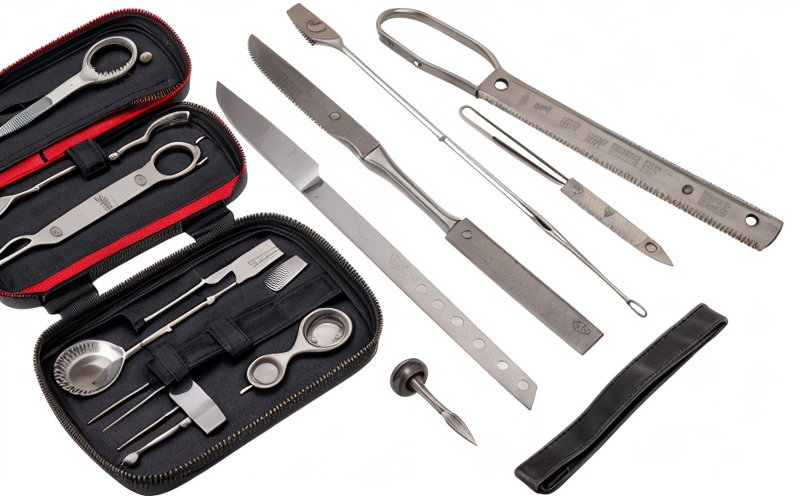ISO 7153-2 Corrosion Resistance Testing of Surgical Instruments
The ISO 7153 standard is a cornerstone in the quality assurance process for surgical instruments, ensuring that these critical medical devices meet stringent corrosion resistance requirements. This testing protocol is essential to safeguard patient health and ensure instrument longevity during use.
Corrosion can significantly affect the integrity of surgical instruments, leading to potential failure or degradation of performance. ISO 7153-2 specifically addresses the electrochemical aspects of corrosion resistance by subjecting samples to aggressive environments that mimic real-world conditions. This testing helps manufacturers identify and mitigate risks associated with material selection and processing methods.
The standard requires a series of steps, including specimen preparation, immersion in electrolytic solutions, measurement of weight loss over time, and visual inspection for pitting or general corrosion. The results are compared against specified tolerances to determine compliance.
Compliance with ISO 7153-2 is not only about meeting regulatory requirements but also enhancing brand reputation and patient safety. By adhering to this standard, manufacturers can demonstrate their commitment to quality and reliability in product design and manufacturing processes.
The methodology involves several key steps:
- Selection of test specimens
- Preparation of the electrolytic solution
- Immersion of samples for a specified duration
- Weighing before and after testing
- Visual inspection for corrosion indicators
The results are quantified by calculating weight loss, which is compared against the allowed limits set out in the standard. Compliance with these limits indicates that the surgical instrument can withstand corrosive environments without compromising its structural integrity.
ISO 7153-2 testing is particularly relevant for high-stress areas of surgical instruments where corrosion could lead to failure, such as the cutting edges or joint mechanisms. The test results provide valuable insights into the performance characteristics and durability of these critical components under expected operating conditions.
In addition to the technical aspects, compliance with ISO 7153-2 also supports broader quality management systems (QMS) that ensure consistent production processes and product reliability. This testing is often integrated into larger quality assurance programs to maintain a high standard of care in surgical environments.
Adhering to this standard not only enhances the safety and efficacy of medical devices but also fosters trust among healthcare providers, regulatory bodies, and patients. The test results are crucial for ongoing development and improvement of surgical instruments, ensuring they meet or exceed global standards.
Scope and Methodology
The ISO 7153-2 standard provides a comprehensive approach to evaluating the corrosion resistance of surgical instruments. The scope includes the testing parameters, specimen preparation, immersion conditions, and evaluation criteria.
The methodology involves several critical steps:
- Selecting appropriate test specimens that represent the expected use environment
- Preparation of a standardized electrolytic solution with controlled pH and temperature
- Immersion of samples for a specified duration (typically 168 hours)
- Weighing before and after testing to measure weight loss
- Visual inspection for signs of corrosion such as pitting or general degradation
The standard specifies the acceptable limits for weight loss, which are determined based on the type of material used in the surgical instrument. Exceeding these limits indicates a potential risk of failure under corrosive conditions.
Compliance with ISO 7153-2 is crucial for ensuring that surgical instruments maintain their integrity and performance throughout their intended lifespan. This testing helps manufacturers identify materials and processes that are most resistant to corrosion, thereby improving the overall quality and reliability of medical devices.
The results of this testing are not only used for compliance purposes but also provide valuable data for ongoing research and development efforts aimed at enhancing product design and performance.
Industry Applications
The application of ISO 7153-2 corrosion resistance testing is particularly important in the medical device sector, where quality and reliability are paramount. This standard ensures that surgical instruments meet the highest standards of durability and safety.
Surgical instruments subjected to this test include a wide range of tools such as scalpels, forceps, scissors, and retractors. These devices are often exposed to harsh conditions during use, making corrosion resistance a critical factor in their performance.
The testing process is particularly relevant for high-stress areas like the cutting edges or joint mechanisms of surgical instruments, where even minor degradation can lead to failure. By adhering to ISO 7153-2, manufacturers can ensure that these devices remain effective and safe throughout their operational life.
Compliance with this standard is also crucial for maintaining compliance with broader regulatory requirements such as those set by the U.S. Food and Drug Administration (FDA) or European Union Medical Device Directives. This ensures that surgical instruments are not only of high quality but also meet international standards, enhancing their acceptance in global markets.
The test results provide valuable insights into the performance characteristics and durability of these critical components under expected operating conditions. This information is invaluable for ongoing development and improvement of surgical instruments, ensuring they meet or exceed global standards.
International Acceptance and Recognition
- The ISO 7153-2 standard has gained widespread acceptance in the medical device industry worldwide. It is recognized by regulatory bodies such as the FDA, EU, and other global health authorities.
- Countries like the United States, Canada, Europe, Australia, and Japan have incorporated this testing protocol into their respective regulations for surgical instruments.
- The standard ensures that medical devices meet stringent quality and safety requirements, which is crucial given the high stakes involved in healthcare.
Adherence to ISO 7153-2 not only demonstrates a commitment to quality but also enhances brand reputation and patient trust. By aligning with international standards, manufacturers can ensure their products are accepted and trusted globally.





